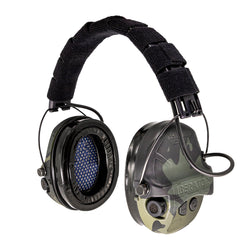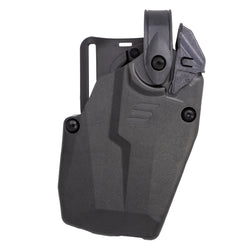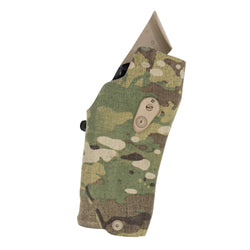In our daily lives, we often move from place to place with our minds preoccupied. We think about work, family, or what we’ll have for dinner. But threats can emerge unexpectedly, so maintaining a state of relaxed awareness is important.
As I talked about in our article “Situational Awareness: Practical Habits for Daily Vigilance,” being aware of your surroundings is not about being paranoid. It’s about being proactive and alert. A fundamental aspect of this situational awareness is the ability to quickly identify sources of safety.
This is where the critical distinction between cover and concealment comes into play. Understanding this difference can be the deciding factor in a violent encounter.
Recognizing what can protect you from being seen versus what can protect you from being shot is a non-negotiable skill. It informs your movement, your positioning, and your decision-making under duress. For those who are not entirely sure what the difference is between cover and concealment, here is a helpful guide.
What is concealment?
In the context of an incident involving firearms, concealment is anything that can hide you from a threat’s view. It is a barrier to observation. This can be anything from a thick bush to a standard interior door, privacy fence, etc. The primary purpose of concealment is to break the adversary’s line of sight. If a threat cannot see you, they cannot effectively engage you with direct fire. This visual break can offer a significant tactical advantage.
It is important to understand, however, the limitations of concealment and how it differs from cover. While concealment may hide your presence, it will not stop incoming rounds. A bullet will easily penetrate most common forms of concealment. Think of items like drywall, car doors, wooden tables, or even standard residential windows. These may obscure you from view, but they offer little to no ballistic protection.

Because of Hollywood movies, concealment is often confused with cover. I can’t recall the number of movies I’ve watched where someone flips over a table as someone sprays bullets at them with a machine gun.
Or how about hiding behind the door of a car as you see the bullets hit the door just on the other side of the person? In real life, those bullets would go right through a car door.
This does not mean concealment is useless. In fact, it can be a valuable tool when used correctly. You may be able to hide from a threat or make him confused as to your exact location. This moment can be your window of opportunity to move to a better position, draw, or escape the area entirely.
Concealment is not a final destination; it is a temporary waypoint. It’s a tool to be used just like any other tool in our toolbox.
What is cover?
Where concealment hides you, cover protects you. Cover is any material or object that can reliably stop incoming bullets. This is the most significant difference between the two.
When faced with a lethal threat, your immediate priority should be to move to a position of cover. Cover can also provide concealment, but concealment does not provide cover… make sense?
Once you understand what cover is, you should also be aware that not all forms of cover offer the same protection. For instance, a cylinder brick wall offers limited protection against most handguns and some rifles. But because it is hollowed on the inside, it will start to break apart quickly.

In contrast, a poured concrete wall offers exceptional protection against most handguns and rifles. Of course, bullets could eventually penetrate a wall like this as well, but it would take much longer.
Other examples of good cover include the engine block of a vehicle (as opposed to the doors and windows), large, mature trees, concrete pillars, etc.
It is also important to consider the nature of the threat when evaluating cover. What may serve as adequate cover from a 9mm handgun might not be effective against a high-velocity rifle round. This concept of “relative cover” is why we must constantly assess our surroundings.
The key is to find the most substantial and durable object between you and the threat. Sometimes there is not a lot to work with, but understanding the difference will help you pick your best options.
Applying Knowledge in a Threat Scenario
Understanding the definitions of cover and concealment is the first step. The true test comes in applying this knowledge under the extreme stress of a critical incident. Your ability to move and make sound decisions will are put to the test under a stressful event.
The OODA Loop: Deciding Under Pressure
As I’ve mentioned in other articles, one method for making decisions under pressure is called the OODA Loop. Observe, Orient, Decide, and Act. This concept was developed by military strategist John Boyd and is directly applicable to self-defense scenarios.

- Observe: You perceive the threat and your surroundings. You see where the danger is coming from and what potential cover and concealment options are available.
- Orient: This is the most critical phase. You process the information based on your training, experience, and understanding of the situation. You recognize that the wooden table is only concealment, while the concrete pillar is cover.
- Decide: You make a choice based on your orientation. You decide to bypass the flimsy table and move toward the solid pillar.
- Act: You execute your decision. You move with purpose and speed to get behind that cover.

The individual who can cycle through their OODA Loop faster and more effectively than their adversary gains a significant advantage. By having a pre-existing understanding of cover versus concealment, you streamline your orientation and decision-making processes.
Principles of Tactical Movement
Once you’ve identified a position of cover, moving to it becomes the next challenge. Simply running in a straight line may not be the best option. During range time, I like to practice moving from one area of cover to another while drawing from my IWB concealed carry holster to firing at a target.

- Move with Purpose: When you decide to move, do so quickly and aggressively. Hesitation can be fatal.
- Minimize Exposure: Move in a way that presents the smallest possible target. Stay low and move from one piece of cover or concealment to the next.
- Don’t Crowd Your Cover: Once you reach a position of cover, avoid pressing your body directly against it. This can make you a larger target if the threat attempts to flank your position. It also allows debris from bullet impacts to potentially cause injury. Giving yourself a small amount of space so you have better maneuverability and a wider field of view.
- The Dangers of Fixation: Do not become so focused on one piece of cover that you lose awareness of the overall situation. Always be looking for the next best position to improve your tactical advantage or to create a path for escape. Cover is a temporary shield, not a permanent solution.
Learn, practice, perfect
From my experience, anyone can improve their skills regardless of their skill level. Some of the most capable people I know are the ones who train the most and the ones who seek out knowledge.
When you learn something new, decide how it applies to you. You may want to tweak a few things or combine it with something else you learned. But once you know what you need to do, start practicing.
They say practice makes perfect, right? I’m not sure any of us will ever become “perfect” at something, which is why we can always get better. Our goal is to perfect what we learn, even if we never reach our goals.
And now that you have a better understanding of cover verses concealment, start paying attention as you go about your daily routine. Start practicing and start perfecting.











